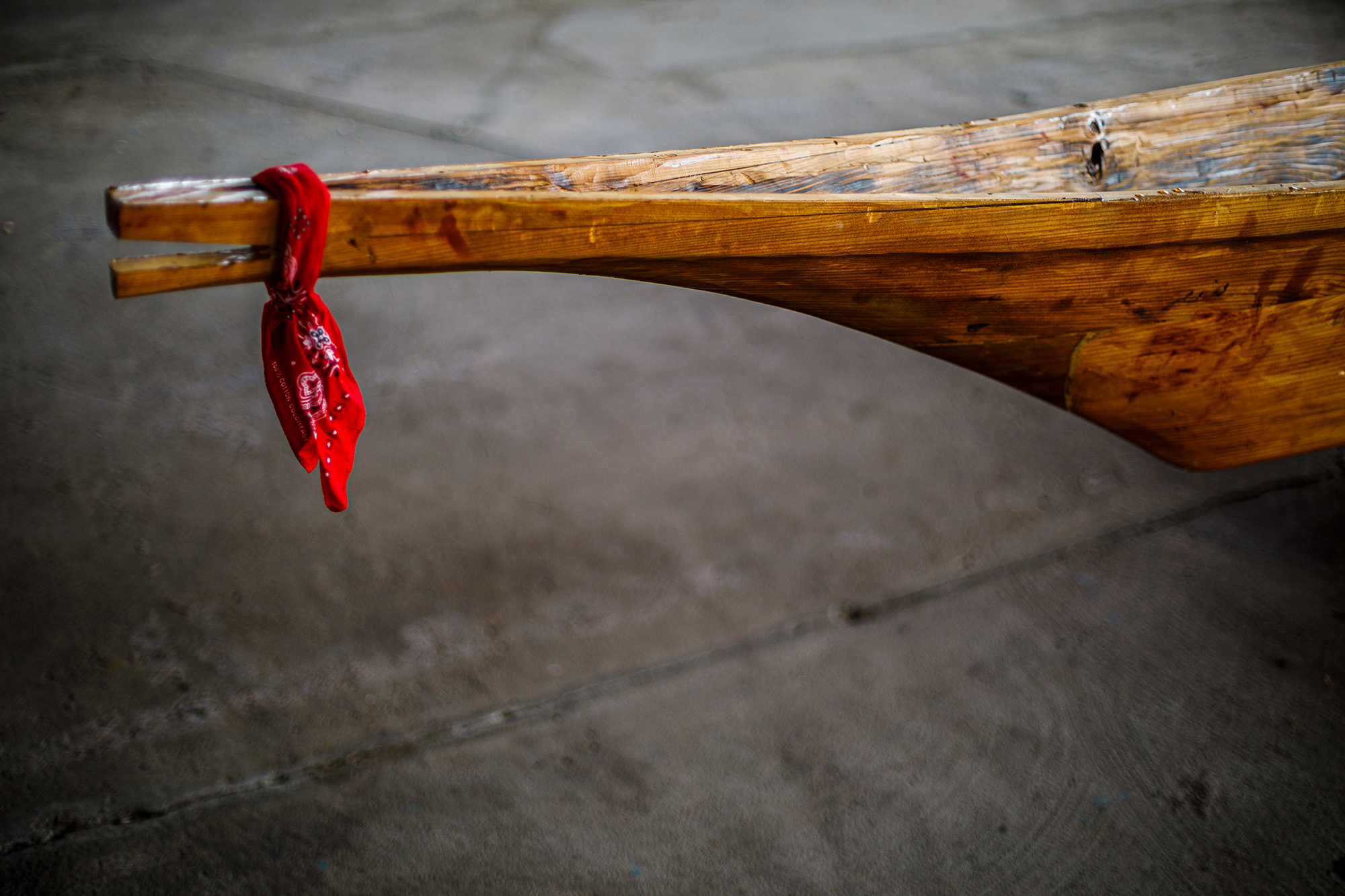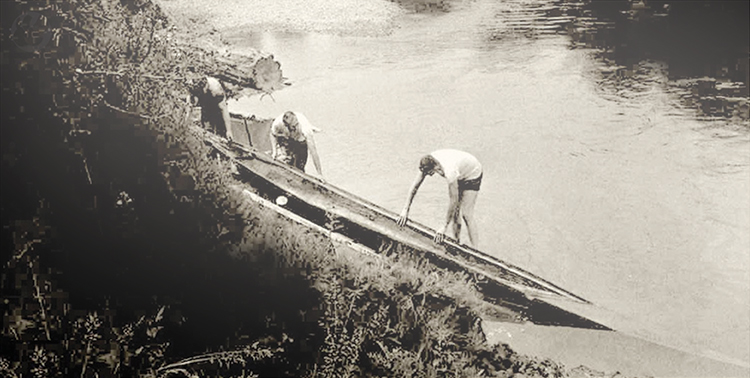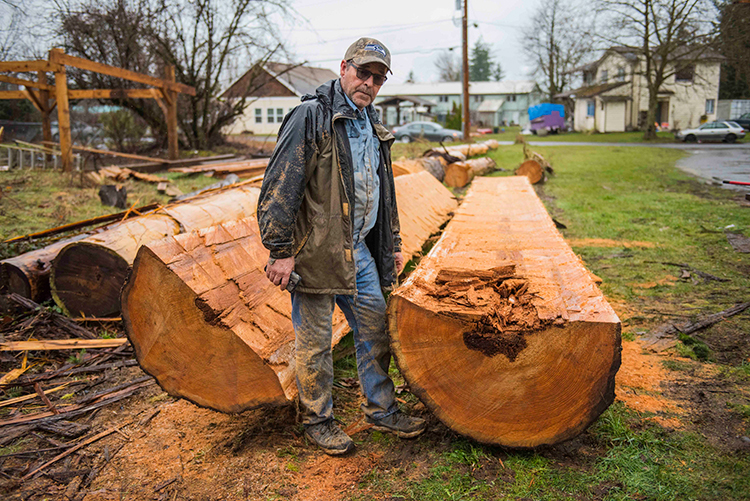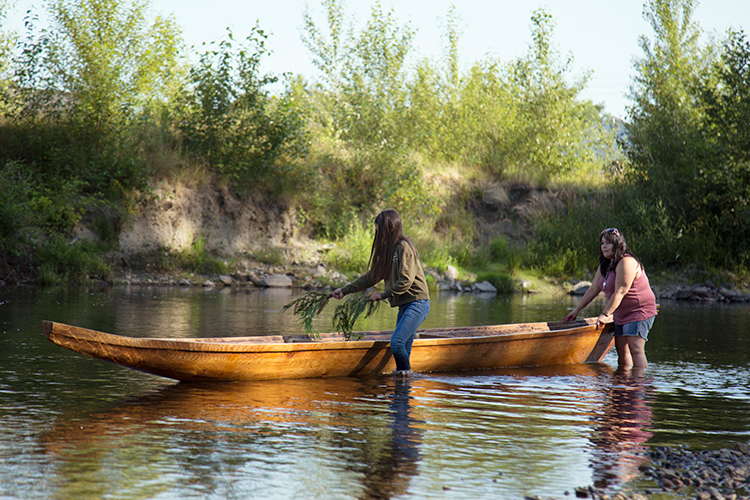Unearthed and retooled Unearthed and retooled Unearthed and retooled
The unlikely story of two carved canoes, divided by decades, linked in tribal tradition.

The unlikely story of two carved canoes, divided by decades, linked in tribal tradition.
Sometimes an amazing mystery will emerge from the mud. In 1963, for example, 10-year-old David Monstad found a treasure tucked into a riverbank on a neighbor’s farm.
A Washington kid with plenty of nature to explore, Monstad often ventured to the Green River, which bordered his family’s farm. One midsummer day, he discovered a long canoe poking out of a muddy embankment.
Thinking he had come across a free canoe, he tried to dig it out. Then, he realized he probably should tell his neighbors about his find. Excited by the news, they started making plans to pull the boat free with a tractor. But then another person who was fishing on the river saw the canoe and recognized it as a Native American dugout vessel. And he called the Burke Museum.
A museum collections worker reached out to the landowners and dispatched three graduate students down to the river. In shorts and T-shirts, armed with shovels and trowels, the young men spent several sunny days extricating the 25-foot bark. They brought it back to the Burke, where it was recorded, cataloged and then tucked away into storage.
Four decades later it was discovered again.
Peter Lape joined the anthropology faculty and the staff at the Burke Museum in 2000. His research focuses on Island Southeast Asia as well as public archeology, practice and resource management in the Seattle area.
Three years after arriving at the UW, he discovered the canoe. He was helping move artifacts in a museum storage facility at the old Sand Point Naval Air Station. The massive warehouse is filled with canoes, carvings and cultural artifacts. It’s an easy place to get distracted, and an easy place to overlook something humble. But Lape has a sharp eye. “There was this pile of boards and the collection manager said, ‘Oh, that’s a canoe,’ ” he says. Lape paused for a deeper look.

The recreation of the original hunting canoe is now housed in the ASUW Shell House where scholars and students can study it and even take it out on Union Bay to experience how it handles in the water. (Photo and lead photo by Mark Stone)
When the canoe was first discovered in that muddy bank four decades earlier, it was in nearly perfect, though waterlogged, condition, he says. “But once a wooden artifact is removed from the mud and exposed, and you don’t deal with it, it sometimes turns to dust. In 1963, the curators didn’t have the resources or knowhow to protect the wood.” After 40 years in dry storage, “this one had warped and split into chunks. We lost what the canoe looked like when it was discovered.”
Still, Lape felt he had found something special—something that may have predated white settlement. As he was burdened with other projects, he filed away the memory of the canoe until he had the time, resources and ability to bring the right people together to care for it.
“Before contact or precontact,” the time before European explorers sailed and walked their way into the Pacific Northwest— the Puget Sound was a vibrant, lively place. For thousands of years, the Salish people depended on water systems for food and transport. “Those waterways were instrumental in helping people connect with their extended family and friends,” says Warren KingGeorge, ’12, a historian with the Muckleshoot Tribe whose ancestral lands and waterways included the Green River. “The water is one thing that is always there and something we rely on. Also today, we take it for granted and we abuse it.” Many of the elements of pre-contact life have all but disappeared: “the Olympia oyster, the Roosevelt elk, the sockeye that were native to Lake Washington,” he explains. “The Ballard Locks went in and the Black River [a tributary that drained Lake Washington before the ship canal was built and lowered the lake] was essentially erased.”
Despite the human activity and development, portions of the wild Pacific Northwest still exist in the rivers and water systems of today. And a canoe culture persists within Northwest Native communities with canoe carvers, canoe racing and an annual Tribal Canoe Journey that brings out hundreds of boats from tribes throughout the West Coast. Finding and studying this canoe, or in Lushootseed language, the s.dəxʷìł, offered a new dimension to that world.
“This project allowed us to remember why the river does what it does, and why the lake is sitting where it is, and why it’s important to have old-growth cedar for creating a vessel to navigate the water system,” says KingGeorge. “It lets you put yourself in the precontact era. It is a once-in-a-lifetime project.”

Decades ago, the Burke Museum sent three archaeology graduate students to the Green River near Auburn to excavate a pre-contact hunting canoe that had emerged from the mud of the riverbank. (Photo courtesy of Burke Museum)
How did the s.dəxʷìł get there? “There’s lots of theories,” KingGeorge says from across a conference room table at the Muckleshoot tribal headquarters in Auburn, about 25 miles from where the canoe was found. One theory—suggested by archeologists—is that its owner pulled it ashore to go inland and simply never returned.
KingGeorge has another idea. “There was once in place an honor system. You could borrow a neighbor’s canoe or a friend’s canoe and use it to transport,” he says. “You could leave your canoe there or you could moor your canoe on a bank and it would be safe.” It was common to see a hunter’s canoe or a family’s canoe resting on the shore. “My theory is the owner left that canoe and swapped it out for a shovel-nose canoe to continue his journey upriver, maybe following the huckleberries or the hunting season.” He came up with this theory after paddling downriver from the discovery site. “There are lots of depth changes and learning to maneuver the canoe in the river—when it is tight and swift—is challenging,” he says. “Poling a shovel-nose canoe would be easier, especially going upstream where the river is moving fast.”
KingGeorge came to the UW in the early 1990s as an undergraduate to study fishery sciences. His academic pursuit translated into a fisheries job with the tribe before his interest in history inspired him to collect stories, perform research and share his understanding of his community and culture. In 2000, he became the tribe’s historian. Three years later, he joined the Burke’s Native American Advisory Board and has been working with museum archeologists ever since.
This s.dəxʷìł was in KingGeorge’s awareness for years. While trolling through newspaper stories for a research project about the Green River, he found a 1963 article about the canoe’s discovery. “I thought it was interesting,” he says. “There were photographs of the UW students doing the excavation. And when they took it out, it looked in really good condition.”
Then, a few years later, he came across the boat again—though it took him a while to realize it was the same one. On a visit to Seattle to lecture about vessels to one of Professor Sven Haakanson’s classes, KingGeorge made a stunning discovery. The class was visiting the Sand Point storage facility to look at examples of boats. “I was just talking away to those young students and while I’m talking, I’m staring at this canoe,” KingGeorge says. “I said, ‘Sven, I need a minute here.’” Haakanson halted the class while KingGeorge got down on his hands and knees to examine the boat. After looking closely at the prow, he proclaimed, “This looks like a hunting canoe. It is not a shovel nose!” The latter has a blunt prow and a flat bottom. The new canoe had a pointed prow, the kind KingGeorge had seen in old photographs.
“It’s the only hunting canoe I’ve seen in real life,” he says. “It blew my mind.” Haakanson called the class back together and made the whole experience a moment of learning. He said the discovery of what now appears to be an extremely rare canoe was exactly why the museum interacts with local tribes when working on subjects that involve Native people. “He said, ‘This is what can happen when we do the right thing. This is how good things happen,’” KingGeorge says.

Master canoe carver George Swanaset Sr. (Nooksack) studied the ancient canoe before transforming a log from the Cedar River Watershed into a new version. (Photo courtesy of Burke Museum)
The canoe came back into KingGeorge’s life one more time. It was 2014, and Peter Lape called to ask if KingGeorge would be interested in helping build a replica of a boat in the museum’s archives. “I know the canoe you’re talking about!” KingGeorge shouted.
“We schemed together to try to find some money to document what we had and determine what we could do with it,” says Lape, who managed to secure a small grant of $2,000 from the Traditional Small Craft Association. It was just enough to pay for radiocarbon dating and measures to preserve what was left of the canoe. Clues indicated that it had been repaired a number of times. Cedar canoes often crack, and this one had a couple of long fissures in the hull. One crack was repaired with wood—a technique of sewing the craft back together using a cedar thread—which suggested the repair had taken place prior to white settlement. But another crack was fixed with square, hand-cut iron nails. “Those were around here in the 1840s, ’50s and ’60s,” says Lape. “Probably, this canoe was an object made and used before a lot of non-native settlement.”
Radiocarbon dating set the boat in a period between 1820 and 1900. “It confirmed what we were guessing,” says Lape. “We think it was probably made in the 1830s to 1840s.”
A visiting student working on a master’s degree in maritime archeology offered to help. He made hundreds of digital images of the canoe’s pieces and painstakingly assembled them into 3-D renderings. The images allowed the team to make measurements and create little models on a 3-D printer.
They then decided to enlist a carver to create a life-size replica: KingGeorge’s father-in-law, George Swanaset Sr., a member of the Nooksack Tribe who is well-known for carving racing canoes. “We needed someone to help us who really understood the shapes and hydrodynamics,” says Lape. “George is really into traditional canoe-making, but he also has the latest technology. In his shop, you see stone tools and Makita power planers.” KingGeorge facilitated the donation of a cedar tree from the Cedar River Watershed from Seattle Public Utilities. It was trucked up to Swanaset’s workshop in Everson where he spent nine months studying it and carving it. “At first he thought it was a very odd-looking canoe, and he was not happy about doing it,” says Lape. “But then he got into it, cutting the wood and getting a sense of it. He liked it more and more.”
When the boat was complete, in summer 2017, a small group—two archeologists, a few students and KingGeorge and his family—brought it near the site where the original was discovered and introduced it to the river. KingGeorge’s wife and their granddaughter Kalena performed a blessing ceremony. From there, they paddled downstream, with two support kayaks alongside. As it moved down the river, the reasons for its design became clearer; Its prow and hull shape made it suitable for lower, wider river areas and estuaries. It could go into rivers, but it could also maneuver, though not quickly, on open water.
Recreating the s.dəxʷìł with members of the tribal community and a tribal historian was a type of project Lape hadn’t done before. But the collaboration benefitted everyone. “We learned how old it is, we learned about its performance on water, how many miles a day you can paddle, what does it carry.” He also found that the project was much more about bringing people together and getting a sense of what life here was like 150 years ago. “Even though the region was densely forested and there were no roads or cars, you would have been able to easily move around,” he says. “The upper river is beautifully clear. There were lots of fish and tons of birds. It was magical and beautiful.”
Finally, the project caused Lape to think differently about museum collections—which for so long focused on protecting and storing objects of importance. “The bigger question is what do we do with all these objects, and what’s their purpose,” says Lape. “I’m always looking for an answer to that question.”

The replica of the ancient hunting canoe was launched in the Green River last summer. Kalena Delgado, helps her grandmother, Elizabeth Swanaset King George (Nooksack/Cowichan/Laq’amel), bless the canoe before its first voyage. (Photo courtesy of Burke Museum)